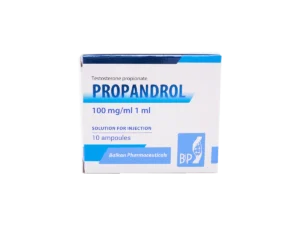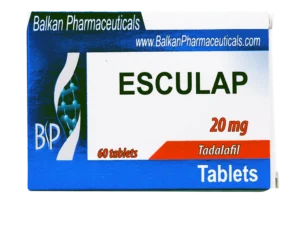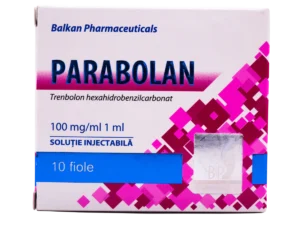Summary of product characteristics
1. NAME OF THE MEDICINAL PRODUCT
Propandrol, 100 mg/ml 1 ml solution for injection
Propandrol, 100 mg/ml 10 ml solution for injection
2. QUALITATIVE AND QUANTITATIVE COMPOSITION
Each ml of solution for injection contains 100 mg of testosterone propionate.
Each 1 ml ampoule contains 100 mg testosterone propionate.
Each 10 ml vial contains 1000 mg testosterone propionate.
For the full list of excipients, see section 6.1. 3.
3. PHARMACEUTICAL FORM
Solution for injection.
Clear, colorless or light yellow oily solution.
4. CLINICAL DATA
4.1 Indications for therapeutic use
In men
Testosterone replacement therapy for male hypogonadism when testosterone deficiency was confirmed by clinical features and biochemical tests. It is used as substitution therapy in castrated adults and those who are hypogonadal due to pituitary or testicular disease.
In women
It can also be used to control breast carcinoma in postmenopausal women.
4.2 Dosage and method of administration
Method of administration
Intramuscularly deep. The dose is determined individually depending on the patient’s indications and reactivity.
Men in hypogonadism are given 50 mg 2-3 times a week. In the case of delayed puberty and cryptorchidism, 50 mg per week is administered.
In women for control of postmenopausal breast cancer, 100 mg is administered 2-3 times per week.
Additional information for special patients
Special patient groups
Children and adolescents
Testosterone propionate is not indicated for use in children and adolescents and has not been clinically evaluated in men below 18 years of age (see section 4.4).
Elderly patients
Limited data did not suggest the need for dose adjustment in elderly patients (see section 4.4).
Hepatic impairment
No studies have been performed in patients with hepatic impairment. The use of testosterone propionate is contraindicated in men with hepatic tumors present or history (see section 4.3).
Kidney failure
No studies have been performed in patients with kidney problems.
Administration method
Intramuscular use.
The injections should be administered very slowly (for two minutes). Testosterone propionate is used strictly for intramuscular injection. Care must be taken to inject deep testosterone propionate into the fossil muscle after the usual precautions for intramuscular administration have been taken. Special care should be taken to avoid intravascular injection (see section 4.4). The contents of the ampoule will be injected intramuscularly after the opening, the remaining solution will be discarded. Propandol solution for injection in vials may be used several times after the first injection provided that the vial cap was not removed and the remaining contents remained hermetically sealed.
4.3 Contraindications
– androgen-dependent carcinomas – prostate or mammary gland in man;
– hypercalcaemia that accompanies malignant tumors;
– liver tumors in the past or present;
– diabetes mellitus;
– heart or coronary insufficiency;
– history of myocardial infarction;
– atherosclerosis in elderly men;
– pregnancy, lactation period;
– hypersensitivity to the active substance or to any of the excipients listed in section 6.1.
4.4 Special warnings and precautions for use
Elderly patients treated with androgen may be at risk of developing prostatic hyperplasia. Although there are no clear indications of the androgen challenge of prostate cancer, they can increase the chances of developing an already existing prostate cancer. Thus, prostate cancer should be excluded before starting treatment with testosterone.
As a precaution, regular prostate examination in men is recommended.
In patients with long-term androgen therapy, hemoglobin and hematocrit should be monitored regularly to detect polycysticemia (see section 4.8).
Cases of malignant and benign liver tumors have been reported with users of hormonal substances, such as androgenic compounds. If abdominal pain, liver enlargement or signs of intraabdominal haemorrhage occur in men using testosterone propionate, an abdominal tumor should be considered for differential diagnosis. Caution should be taken in patients with edema-predisposition, since androgen therapy may increase sodium retention (see section 4.8).
No clinical trials with testosterone propionate have been conducted in children or adolescents under 18 years of age.
In children, testosterone, in addition to masculinization, can cause accelerated growth and bone maturation and premature closure of the epiphysis, thereby reducing the final height. It is also possible to develop common acne.
Androgens are not suitable for improving muscle development in healthy people or increasing physical abilities.
In patients with severe heart, liver or kidney disease or ischemic heart disease, treatment with testosterone can cause severe complications, characterized by swelling accompanied with congestive heart failure. In this case, treatment should be stopped immediately.
Testosterone may cause an increase in blood pressure and should be used with caution in men with hypertension.
Concentration of testosterone should be monitored at baseline and at regular intervals during treatment. Doctors need to adjust the dose for each patient in order to ensure the maintenance of the eugonadal testosterone concentrations.
Also, patients with long-term androgen therapy should be monitored regularly for the following laboratory parameters: hemoglobin and hematocrit, functional liver and lipid profile.
Experience with the safety and efficacy of testosterone use in patients over 65 years of age is limited. There is currently no consensus on age-specific testosterone reference values. However, it should be taken into account that the physiological serum concentrations of testosterone are lower as the elderly.
A low dose may be recommended in elderly patients male, because hyperstimulation may occur.
Virilism can occur in high-dose female patients.
Like all oily solutions, Propandrol should be injected strictly intramuscularly and very slowly. In rare cases, pulmonary microembolism of oily solutions may cause symptoms such as cough, dyspnoea, malaise, hyperhidrosis, chest pain, dizziness, paraesthesia or syncope. These reactions may occur during or immediately after the injection and are reversible. Treatment is usually supportive of vital functions, such as supplemental oxygen administration.
Suspected anaphylactic reactions following injection of testosterone propionate have been reported.
In very rare cases, the oily solution in ampoules could form small crystals. In this situation, the contents of the vial prior to injection should be heated in a hot water bath for 15-20 minutes. If the crystals disappear and the solution becomes transparent and after cooling to (37 ± 1) ° C and the crystals do not form again, the preparation can be used, otherwise the ampoule should not be used.
4.5 Interaction with other medicinal products and other forms of interaction
Medications that affect testosterone
Barbiturates and other enzymatic inductors
Interactions with microsomal enzyme-inducing drugs can occur, which may lead to increased clearance of testosterone which reduces its effect.
The effects of androgen on other drugs
Oxyphenbutazone
Increased levels of serum oxyphenbutazone have been reported.
Oral anticoagulants
Testosterone and its derivatives have been reported to increase the activity of oral anticoagulants, with dose adjustments possible. Independently of these results, limiting the use of intramuscular injections in patients with hereditary or acquired blood clotting problems should be considered as a general rule.
Hypoglycaemic drugs
Androgens can potentiate the effects of insulin to lower blood sugar. Thus, it may be necessary to reduce the dose of hypoglycaemic drugs. Propandrol can also affect the results of laboratory tests (for example thyroid gland).
4.6 Fertility, pregnancy and lactation
Fertility
Testosterone replacement therapy can reversibly reduce spermatogenesis (see section 4.8 and section 5.3).
Pregnancy and breast-feeding
Propandrol is not indicated in women and should not be used in pregnant or lactating women, see section 4.3.
4.7 Effects on ability to drive and use machines
Propandrol does not affect the ability to drive or use machines.
4.8 Undesirable effects
Adverse reactions to testosterone propionate are specific to androgen use. The most common side effects during testosterone treatment are acne and pain at the injection site. Table 1 presents adverse drug reactions (RAM) based on organ systems following the MedDRA classification with testosterone, and these can be:
Common (≥ 1/100 and <1/10).
Uncommon (≥ 1/1000 and <1/100).
Table 1
| Classification by apparatus,
systems and organs | Common | Uncommon |
|
Blood and lymphatic system disorders | Polycythemia Increase in hematocrit values Increase in Erythrocyte count Increase in hemoglobin values | |
| Immune system disorders | Hypersensitivity | |
| Metabolic and nutritional disorders | Weight gain | Increased appetite Increased glycosylated hemoglobin Hypercholesterolaemia Increased serum triglycerides Increased serum cholesterol levels |
| Psychiatric disorders | Depression Emotional disorders Insomnia Agitation Aggressiveness Irritability | |
| Nervous system disorders | Headache Migraines Tremour | |
| Vascular disorders | Hot flushes | Cardiovascular disorders Hypertension Increased blood pressure Dizziness |
| Respiratory, thoracic and ediastinal disorders | Bronchitis Sinustis Cough Dizziness
Snoring Dysphonia | |
| Gastrointestinal disorders | Diarrhea Nausea | |
| Hepatobiliary disorders | The liver function test is abnormal Increase in serum ASAT | |
| Skin and subcutaneous tissue disorders | Acne | Alopecia Rash Erythema maculo-transient papules Rash Zruritus Dry skin |
| Musculoskeletal and connective tissue disorders | Arthralgia Pain in the extremities Spam the muscle Muscle tension Myalgia Muscular and skeletal blockage Blood creatinine increase | |
| Renal and urinary disorders | Reduction of urinary flow Urinary retention Urinary tract disorders | |
| Reproductive system and breast disorders | Increased prostate specific antigen Examination of the abnormal prostate Benign prostatic hyperplasia | Prostate intraepithelial neoplasia Strengthening the prostate Prostatitis
Prostate disorders Increase libido Decrease of libido Testicular pain Breast augmentation Breast Pain Gynecomastia Increased estradiol Increased free testosterone in the blood Increased testosterone in the blood |
| General disorders at the site of administration
| Various types of reactions at the injection site in the form of pain, discomfort, pruritus, erythema, hematoma, irritation, reactions. | Fatigue Asthenia Hyperhidrosis Night sweats |
In rare cases, administration of oily solutions in patients with pulmonary microembolism may lead to signs and symptoms such as cough, dyspnoea, malaise, hyperhidrosis, chest pain, dizziness, paraesthesia or syncope. These reactions can occur during or immediately after the injection and are reversible. In clinical trials, rare cases reported by the company or reporter as having oily pulmonary microembolism (in ≥ 1/1000 and <1/100 injections) and post-marketing experience (see section 4.4) have been rarely reported in clinical trials.
Suspected anaphylactic reactions following injection of testosterone propionate have been reported.
In addition to the above mentioned side effects, treatment with preparations containing testosterone, nervousness, hostility, sleep apnea, various skin reactions including seborrhea, increased frequency of erections and, in very rare cases, jaundice have been reported.
High dose treatment with testosterone preparations generally reverses or reduces spermatogenesis, thus reducing the size of the testicles; testosterone replacement therapy in case of hypogonadism can lead to rare, persistent, painful erections (priapism). High or long-term dosages occasionally increase the appearance of water retention and edema.
Report suspected adverse reactions
Reporting of suspected adverse drug reactions after authorization of the drug is important. This allows further monitoring of the benefit/risk ratio of the drug. Health professionals are asked to report any suspected adverse reactions.
4.9 Overdose
No special therapeutic measures are required unless discontinuation of testosterone therapy or dose reduction.
5. PHARMACOLOGICAL PROPERTIES
5.1 Pharmacodynamic properties
Pharmacotherapeutic group: androgens, 3-oxoandrosten derivatives, ATC code: G03B A03.
Testosterone is the most important male androgen synthesized mainly in the testicles, and to a lesser extent in the cortex of the adrenal glands.
Testosterone is responsible for expressing male characteristics during fetal life, early childhood and puberty development, and subsequently to maintain male phenotype and androgen-dependent functions (e.g., spermatogenesis, accessory sexual glands).
Insufficient testosterone secretion leads to male hypogonadism characterized by low serum testosterone concentrations. Signs and symptoms associated with male hypogonadism include, but are not limited to, erectile dysfunction and decreased sexual desire, fatigue, depressive states, and a lack of secondary sexual characteristics, incomplete development or regression, increased risk of osteoporosis, visceral fat and a decrease in weak body mass and muscle strength.
Exogenous androgen are used to improve endogenous testosterone deficiency levels and associated signs and symptoms.
Depending on the target organ, the testosterone activity spectrum is especially androgenic (eg prostate, seminal vesicles, epididym) or anabolic protein (muscle, bone, hematopoietic, kidney, liver).
The effects of testosterone in certain organs occur after the peripheral conversion of testosterone to estradiol, which binds to estrogen receptors in the target cell nucleus, for example the pituitary, fat, brain, bones and Leydig testicular cells.
Hypogonadal androgens reduce body fat, increase lean body mass, muscle strength, and prevent bone loss. Androgen can improve sexual function and can exert positive psychotropic effects.
5.2 Pharmacokinetic properties
Absorption
Propandrol is a preparation with testosterone propionate active substance, which is administered intramuscularly and thus avoids the phenomenon of first passage of the liver. Following intramuscular injection of testosterone propionate as an oily solution, the compound is immediately released into the blood.
Distribution
In the blood, about 98% of testosterone is coupled to a specific globulin fraction that binds testosterone and estradiol.
Metabolism
Biotransformation occurs in the liver up to various 17-keto-steroids, after conjugation with glucuronic or sulfuric acid.
Elimination
Testosterone is extensively metabolised by the liver and extrahepatic. After administration of radiolabeled testosterone, approximately 90% of radioactivity is eliminated urine as glucuronide and sulphate and 6% is eliminated in the feces after the enterohepatic circuit. Urinary metabolites include androsterone and etiocolanolone.
5.3 Preclinical safety data
There is a limited number of toxicological studies specific for testosterone propionate.
However, testosterone as an active principle is generated by cleaving from the ester.
Acute Toxicity
As in the case of general hormones, the acute toxicity of testosterone is very low.
Chronic toxicity
No effects have been observed that may indicate an unexpected risk to humans during systemic toxicity studies on rodents or non-rodents.
Mutagenic and tumorigenic potential
In vitro and in vivo investigations of the testosterone propionate mutagenicity and testosterone studies did not indicate a mutagenic potential.
Rodent studies indicate an effect of promoting testosterone or its esters on the development of hormone-dependent tumors. Generally, it should be taken into account that sex steroids can promote the growth of certain hormone dependent tissues and tumors.
Toxicity to reproduction
Fertility studies on rodents and primates have shown that testosterone treatment can affect fertility by suppressing spermatogenesis in a dose-dependent manner. Furthermore, no embryoleal or teratogenic effects were observed in male rats treated with testosterone. Testosterone administration may lead to virilization of fetal fetuses at certain stages of development. However, research into embryotoxic effects, particularly teratogenic, did not indicate subsequent damage to organ development.
6. PHARMACEUTICAL PARTICULARS
6.1 List of excipients
Benzyl alcohol, benzyl benzoate, peach oil.
6.2 Incompatibilities
In the absence of compatibility studies, this medicinal product must not be mixed with other medicinal products.
6.3 Shelf life
60 months.
6.4 Special precautions for storage
Keep protected from light and temperatures below 25 °C.
Keep out of the reach and sight of children.
6.5 Nature and contents of container
Cardboard box with 1 ml vials of 2 PVC pills of 5 ampoules.
Cardboard box with 1 vial of 10 ml.
6.6 Special precautions for disposal and other handling
Any unused product or waste material should be disposed of in accordance with local regulations.
CERTIFICATE OF REGISTRATION
SC Balkan Pharmaceuticals SRL N. Grădescu str., 4, MD-2002, or. Chisinau, Republic of Moldova.
The manufacturer
SC Balkan Pharmaceuticals SRL Industrial Street, 7 / A, MD-2091, or. Singera, Republic of Moldova.









